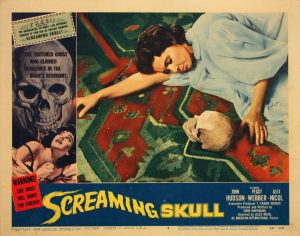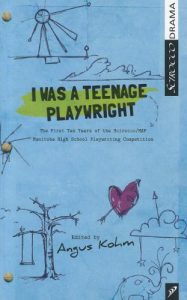I always liked ghost stories. In most of the ones I remember from when I was a kid, there was only one ghost. There may have occasionally been two or three ghosts in a story. But the idea of one movie having thirteen ghosts in it was absolutely unthinkable to me.
I’m not sure how old I was when I first heard mention of the title 13 Ghosts, but I was certainly aware that the movie existed for a long time before I ever saw it. It is not a movie that I watched on late night TV, or on a Saturday afternoon (which is when I saw great films like Abbott and Costello Meet Frankenstein (1948) for the first time). I’m sure that the original 13 Ghosts, would have appealed to me in a similar way when I was a kid. And I was certainly a fan of The Wizard of Oz (1939) back then, which seemed to come on TV at least twice a year (and I watched it every time). So, I liikely would have recognized – and appreciated – The Wicked Witch of the West (or Margaret Hamilton, as some might know her) playing the mysterious housekeeper in 13 Ghosts. But alas, I never saw the movie when I was young.
In 2001, I was a member of the board of the Manitoba Association of Playwrights, and we used to meet once on month on Tuesdays right after work. Like most unsuccessful playwrights, I worked at home, so this meant that I had to walk downtown just as most people were leaving downtown for home. The meetings would often last about two hours, which meant that I would be walking back home around 7:00 PM. And the journey would take me right past the Towne Cinema 8 – which I could remember being built twenty years earlier. It had been a big deal at the time, because it had been Canada’s first stand-alone multiplex cinema.
I would often think, as I walked past, that it would be fun to just stop in and see a movie. But I almost always had other plans, so I would keep walking. But on this particular October evening, there was nowhere else I needed to be. And, I happened to know that there was a horror film playing in honour of the Halloween season.
This was another issue for me. I went to a lot of movies back then. I had friends who would want to go as often as once a week, and it was not unusual for me to wind up at the theatres two or three times in a given week. However, most of my regular companions were not horror fans. They might occasionally agree to go to one, but if it wasn’t spectacular I’d be hearing about it for the next six months. So, I mostly watched horror films on my own, at the Home Drive-In.
The movie playing at the Towne Cinema 8 on this fine October evening was Thir13en Ghosts (2001), the remake of William Castle’s original – which I still had never seen. I don’t usually like to see remakes of classic horror films before I see the originals – in fact, I often don’t like to see them at all – but it had been ages since I’d seen a horror film on the big screen and this seemed like an opportunity that I couldn’t pass up. So, I walked through the front doors, down the set of stairs into the basement, and bought a ticket…
I know that some people enjoyed Thir13en Ghosts, and I suppose that I did too, on some level. But basically I thought that it was a big budget spectacle that was short on quality storytelling. It’s been almost twenty years since I suffered throu -I mean, watched it – so, I can’t really remember enough details to talk about it intelligently. And I will be the first to admit that if I watched it again now, I might, possibly, feel very differently about it. So… The point is, on that October evening in 2001, I vowed that I must finally track down watch the original 13 Ghosts.
Thankfully, because of the remake coming out, the original had been released on video and was pretty widely available. I managed to rent it at my favourite video store, Movie Village. I knew going in that it had to be better than the remake. In fact, I was so sure about that, that I probably raised the bar of my expectations so hight that I expected the film to be a work of brilliance that would make Thir13en Ghosts look look a bad re-run of (’80s robot sitcom) Small Wonder.
Well…
It was definitely better than Thir13en Ghosts, in my opinion. But I have to say that I was just a little bit disappointed in it. 13 Ghosts was not light years better than the remake. It had some of the same problems, it seemed to me in that moment, as Thir13en Ghosts. Again, this was almost 20 years ago and I can’t remember exactly what had turned me off. And it’s not that I hated it. I thought it was pretty good. But I had loved movies like The Tingler (1959) and House on Haunted Hill (1959) so much, that maybe I expected more from William Castle.
But the real culprit, I think, was Thir13en Ghosts. Watching it first, even though I didn’t like it, had somehow cast a shadow over my experience of 13 Ghosts. And as a result, I did not watch the movie again until last Friday. If I hadn’t bought a box set of William Castle Blu-rays, which included 13 Ghosts, I’m not sure if I ever would have.
But I’m really glad I did. This time I went in with much lower expectations. Not really expecting it to be bad – I had thought it was at least decent the first time I saw it – but perhaps I just didn’t have the recent hangover of watching the remake first. And I must admit, that part of me was afraid that I might hate it. However…
I loved it this time! It has a sense of humour, plus some nifty ghost effects (for their time) and some moments of legitimate creepiness and suspense. Had I watched it on a Saturday afternoon when I was a kid, it probably would have thrilled me.
It may still not reach the heights of William Castle’s best work, but 13 Ghosts (1960) is certified #NotQuiteClassicCinema that would be welcome on any #FridayNightAtTheHomeDriveIn or Saturday matinee, and I look forward to watching it again!
 The Amazing Transparent Man (1960) by #EdgarGUlmer
The Amazing Transparent Man (1960) by #EdgarGUlmer



